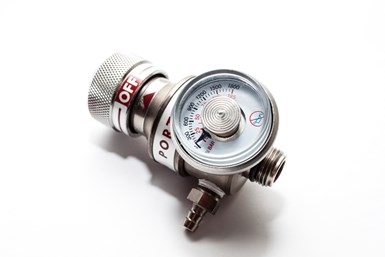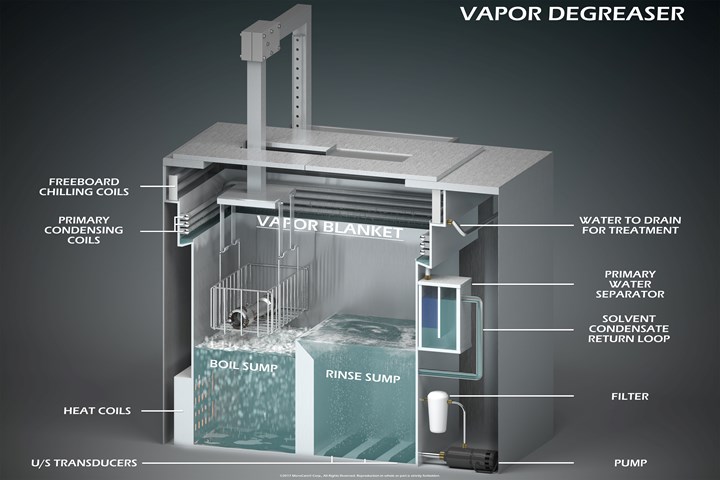
Cleaning parts is critical for ensuring a quality finish, and the stakes are even higher when it comes to finishing aerospace oxygen systems.
Photo Credit: Getty Images
Oxygen systems are critical to flight. Installed in commercial, military and business aircraft, these apparatus must effectively generate a supply of oxygen to passengers and crew at all times, whether in flight at high altitude, or in an emergency situation.
Although essential on aircraft, liquid or gaseous oxygen systems can be a danger to life if the manufactured component parts are not cleaned and dried prior to inspection, assembly and packaging. Any production residue left on the system’s moving parts can cause friction, which can have catastrophic results.
Featured Content

Particles or residue left behind during the manufacturing process may affect the operation of sensors, valves, and controls.
Photo Credit: MicroCare
Contamination — An Explosive Risk
Manufacturing processes for the various components of the oxygen systems leave surface contaminants that need to be removed prior to the assembly of the finished product.
Typical contaminants include dust, welding dross and debris like metal particulate, residues like hydrocarbon-based greases and oils, and inorganic pollutants such as water-based cutting oils and other acids and solvents. Although these contaminants may not be visible to the naked eye, it is critical to the performance and safety of the systems that every single part is precision cleaned and all contamination is removed.
If any production contamination remains on any of the moving parts, friction can be created. This can generate heat when it comes into contact with the residue and combust, auto-ignite or explode inside oxygen-rich systems. Additionally, as the flammable ranges increase and auto-ignition temperatures of the materials utilized in oxygen systems start to decrease, they become easier to ignite. Any remaining particulate can spontaneously ignite and explode in these delicate atmospheres. Therefore, each and every system component must be thoroughly cleaned and dried.
Although fire safety is the most significant reason for cleaning oxygen system components, there are also other important reasons to consider. Any particles or residue left behind during the manufacturing process may affect the operation of sensors, valves, and controls. Furthermore, parts like hoses, tubes, pipes, regulators, and meters, which are vital for the medical oxygen system to perform safely, must comply with rigorous industry quality standards. If they have not been cleaned and dried sufficiently, they will not meet the strict inspection or regulatory requirements.
Methods to Precision Clean
There are several ways that components used in aerospace oxygen systems can be cleaned. Mechanical cleaning is one method that uses a wire brush or sand blasting or grinding to remove scale, paint, coatings or welding dross. Although successful to a certain degree, they can leave behind particulate.
There is also alkaline cleaning using caustic salt dissolved in water. It removes grease, wax, and hydrocarbon oils, and is applied through spraying, immersion, or swabbing the solution. However, it is extremely important that the cleaning solution is thoroughly rinsed to prevent parts damage.
Aqueous cleaning is another popular method to clean within a production facility. This can be done with or without detergents and spray agitation and typically uses very hot water or steam to remove water-soluble contaminants. This cleaning method, however, has drawbacks. The detergent must be rinsed off and the parts dried before further processing. It also uses a lot of water, a precious non-renewable resource that all production facilities should try to preserve. Large amounts of electricity or other power sources are also required to fuel the multiple washing, rinsing and drying machines. Aqueous cleaning systems also need high water and air temperatures to be effective, consuming even more energy. Furthermore, it produces a water waste stream that requires treatment before discharge.
Vapor degreasing is another method that can be used to clean aerospace oxygen systems. When used with advanced cleaning fluids, it is extremely effective at thoroughly removing contamination from parts.
The low viscosity and surface tension ratings of modern vapor degreasing cleaning fluids, combined with their volatility, clean parts very effectively even inside blind holes and tiny openings that other cleaning options like aqueous cleaning cannot easily infiltrate. This ensures that all the surfaces of the finished component are effectively cleaned and dried, ready for further processing or packing.

When used with advanced cleaning fluids, vapor degreasing is extremely effective at thoroughly removing contamination from aerospace parts.
Photo Credit: MicroCare
Why is Vapor Degreasing the Better Cleaning Choice?
When it comes to cleaning the parts used within aircraft oxygen systems, it has to be precise and effective, otherwise, there could be disastrous repercussions. Vapor degreasing ticks all the boxes when it comes to precision cleaning for a number of reasons:
- The low viscosity of modern cleaning fluids used within a vapor degreaser, and their volatility, guarantee they clean very effectively as the fluids can flow in and out of tight part spaces. They also have a low boiling point and evaporate quickly, helping to ensure the cleaning fluid and contaminants don’t get trapped inside end holes or other small crevices often found in these parts. Because there is no residue left behind, any flammability risk is significantly reduced.
- Using vapor degreasing helps to ensure that rigorous regulations are passed. This includes specifications like ASTM G93 - 03(2011), the ‘Standard Practice for Cleaning Methods and Cleanliness Levels for Material and Equipment Used in Oxygen-Enriched Environments’. The Standard provides manufacturers with details on precision cleaning surfaces and areas that come in contact with pure O2 or those operating with pressurized O2. This also includes the use of cleaning equipment and the recommended cleaning materials or fluids to be used on any parts intended for service in oxygen-enriched environments. Advanced vapor degreasing fluids also help to pass environmental regulations. They are created with low-VOC formulas, which are ozone-friendly and comply with many directives including United States EPA regulations and European F-Gas and REACH (Registration, Evaluation, Authorisation and Restriction of Chemicals) legislation. Importantly, they offer improved environmental properties without compromising performance.
- Unlike aqueous cleaning, vapor degreasing cleaning fluids do not harbor pyrogens. They help to maintain an environment free of bacteria, viruses, or other pathogens. The slightest amount of moisture remaining in hard-to-reach areas can encourage bacteria growth, resulting in bioburden risk. Because vapor degreasing finishes the cleaning process by effectively drying the parts, any bio-burden risk is eliminated.
- Vapor degreasing fluids can be used on various materials found within oxygen systems, including stainless steel, low carbon steel and plastics. Because they have a low boiling point and heat of vaporization, they are safer to use on delicate parts like gaskets, seals and components made from mixed materials.
- Vapor degreasing cleaning is a simple, predictable and repeatable process. This makes it easy to qualify and validate. Validation is extremely important when manufacturing parts used within oxygen systems and ensures that parts consistently meet quality standards, including those found in cleanroom settings. In addition, vapor degreasing is consistent with established procedures that can be easily documented.
Setting Sky High Cleaning Standards
Cleaning parts should be a priority for any fabricator as it helps to ensure a quality finish is achieved and that any further processes are completed successfully. However, the stakes are even higher when it comes to manufacturing aerospace oxygen systems. Parts must leave the production floor perfectly clean and dry to meet quality and regulatory requirements, but critically to ensure the health and safety of those using the systems. If all parts are not consistently cleaned, there is a risk not only to the purity of the oxygen system, but also the danger of an explosion.
Vapor degreasing using modern, non-flammable vapor degreasing fluids is a highly effective, consistent cleaning method to remove flammable particulate or residue contamination and prevent any fire or explosion risks. It is safe, fast and effective and also tackles many other manufacturing concerns, from environmental impact to validation and cost implications.
About the Author
Elizabeth Norwood
Elizabeth Norwood is a senior chemist at MicroCare LLC. Visit microcare.com.
RELATED CONTENT
-
Replacing Open-Top Vapor Degreasing in Aerospace Manufacturing
Options and considerations for cleaning aerospace parts as regulations tighten on vapor degreasing solvents.
-
How Vapor Degreasing Helps Medical Devices Cross the Finish Line
Vapor degreaser cleaning can be simple, predictable and repeatable, making it a good fit for medical device manufacturing.
-
Replacing Discontinued Vapor Degreasing Fluids – 3 Things to Consider
What do you do when you learn your trusted line of vapor degreasing cleaning fluids will soon be discontinued? Elizabeth Norwood of MicroCare discusses what you should keep in mind when replacing discontinued vapor degreasing fluids.



















